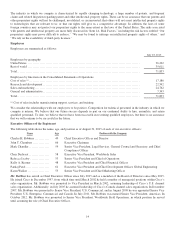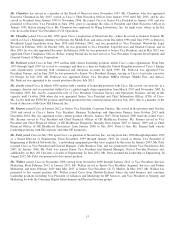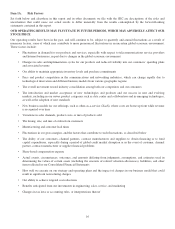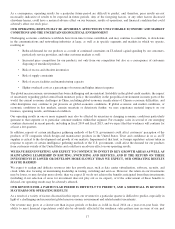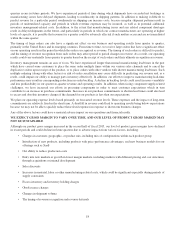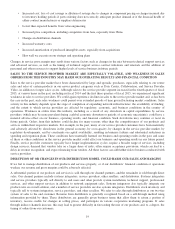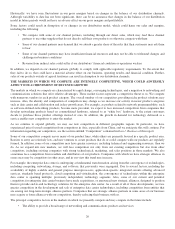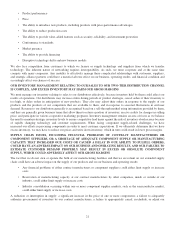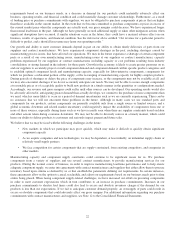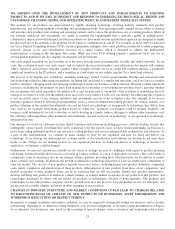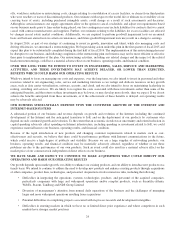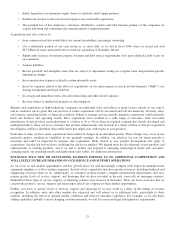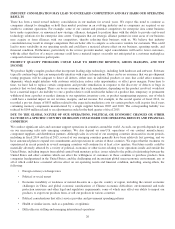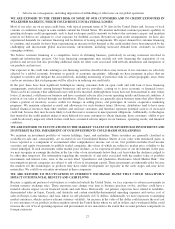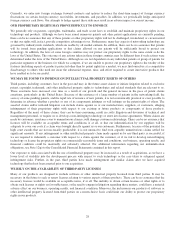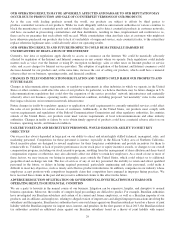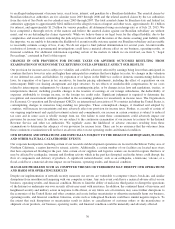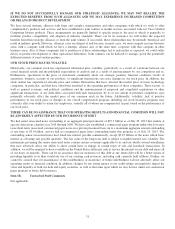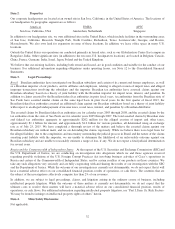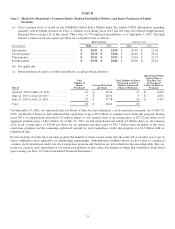Cisco 2015 Annual Report Download - page 31
Download and view the complete annual report
Please find page 31 of the 2015 Cisco annual report below. You can navigate through the pages in the report by either clicking on the pages listed below, or by using the keyword search tool below to find specific information within the annual report.WE DEPEND UPON THE DEVELOPMENT OF NEW PRODUCTS AND ENHANCEMENTS TO EXISTING
PRODUCTS, AND IF WE FAIL TO PREDICT AND RESPOND TO EMERGING TECHNOLOGICAL TRENDS AND
CUSTOMERS’ CHANGING NEEDS, OUR OPERATING RESULTS AND MARKET SHARE MAY SUFFER
The markets for our products are characterized by rapidly changing technology, evolving industry standards, new product
introductions, and evolving methods of building and operating networks. Our operating results depend on our ability to develop
and introduce new products into existing and emerging markets and to reduce the production costs of existing products. Many of
our strategic initiatives and investments are aimed at meeting the requirements that a network capable of multiple-party,
collaborative interaction would demand, and the investments we have made and our architectural approach are designed to enable
the increased use of the network as the platform for all forms of communications and IT. For example, in fiscal 2009 we launched
our Cisco Unified Computing System (UCS), our next-generation enterprise data center platform architected to unite computing,
network, storage access and virtualization resources in a single system, which is designed to address the fundamental
transformation occurring in the enterprise data center. While our Cisco UCS offering remains a significant focus area for us,
several market transitions are also shaping our strategies and investments.
One such market transition we are focusing on is the move towards more programmable, flexible and virtual networks. In our
view, this evolution is in its very early stages, and we believe the successful products and solutions in this market will combine
ASICs, hardware and software elements together. Other examples include our focus on the IoE market transition, a potentially
significant transition in the IT industry, and a transition in cloud where we are architecting the Cisco Intercloud solution.
The process of developing new technology, including technology related to more programmable, flexible and virtual networks
and technology related to other market transitions, including IoE and cloud, is complex and uncertain, and if we fail to accurately
predict customers’ changing needs and emerging technological trends our business could be harmed. We must commit significant
resources, including the investments we have been making in our priorities to developing new products before knowing whether
our investments will result in products the market will accept. In particular, if our model of the evolution of networking does not
emerge as we believe it will, or if the industry does not evolve as we believe it will, or if our strategy for addressing this evolution
is not successful, many of our strategic initiatives and investments may be of no or limited value. For example, if we do not
introduce products related to network programmability, such as software-defined-networking products, in a timely fashion, or if
product offerings in this market that ultimately succeed are based on technology, or an approach to technology, that differs from
ours, such as, for example, networking products based on “white box” hardware, our business could be harmed. Similarly, our
business could be harmed if we fail to develop, or fail to develop in a timely fashion, offerings to address other transitions, or if
the offerings addressing these other transitions that ultimately succeed are based on technology, or an approach to technology,
different from ours.
Our strategy is to lead our customers in their digital transition with solutions including pervasive, industry-leading security that
intelligently connect nearly everything that can be connected. Over the last few years, we have been transforming our business to
move from selling individual products and services to selling products and services integrated into architectures and solutions. As
a part of this transformation, we continue to make changes to how we are organized and how we build and deliver our
technology. If our strategy for addressing our customer needs, or the architectures and solutions we develop do not meet those
needs, or the changes we are making in how we are organized and how we build and deliver or technology is incorrect or
ineffective, our business could be harmed.
Furthermore, we may not execute successfully on our vision or strategy because of challenges with regard to product planning
and timing, technical hurdles that we fail to overcome in a timely fashion, or a lack of appropriate resources. This could result in
competitors, some of which may also be our strategic alliance partners, providing those solutions before we do and loss of market
share, revenue, and earnings. In addition, the growth in demand for technology delivered as a service enables new competitors to
enter the market. The success of new products depends on several factors, including proper new product definition, component
costs, timely completion and introduction of these products, differentiation of new products from those of our competitors, and
market acceptance of these products. There can be no assurance that we will successfully identify new product opportunities,
develop and bring new products to market in a timely manner, or achieve market acceptance of our products or that products and
technologies developed by others will not render our products or technologies obsolete or noncompetitive. The products and
technologies in our other product categories and key growth areas may not prove to have the market success we anticipate, and
we may not successfully identify and invest in other emerging or new products.
CHANGES IN INDUSTRY STRUCTURE AND MARKET CONDITIONS COULD LEAD TO CHARGES RELATED
TO DISCONTINUANCES OF CERTAIN OF OUR PRODUCTS OR BUSINESSES, ASSET IMPAIRMENTS AND
WORKFORCE REDUCTIONS OR RESTRUCTURINGS
In response to changes in industry and market conditions, we may be required to strategically realign our resources and to consider
restructuring, disposing of, or otherwise exiting businesses. Any resource realignment, or decision to limit investment in or dispose
of or otherwise exit businesses, may result in the recording of special charges, such as inventory and technology-related write-
23



